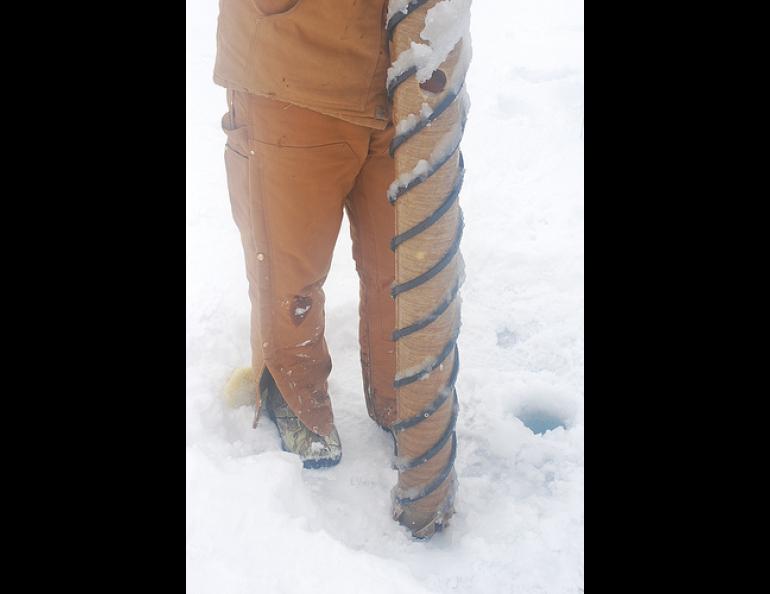

The art of ice coring
The trick to getting a good ice core is to drill straight down into the sea ice, continually clear the slush gurgling up from the ocean, correctly reassemble the core fragments on the tray, take its temperature every couple of inches before it melts or cools, and saw it into hockey-puck-sized chunks without dropping them in the snow.
And, of course, not drop the heavy drill blade on your foot or frostbite your fingers in the process.
“It’s exhausting. Usually I work in front of my computer throughout the day. This time around it’s a lot of walking, carrying out instruments, doing a lot of stuff,” said Alex Semenov, laughing, in between two 3-hour classes on the ice. The wind added a winter chill to the air, and the sun occasionally broke through to light up the sea of ice. “It’s been really interesting and entertaining and scientifically challenging.”
Ice coring was just one skill that Semenov and 21 other graduate students learned in Barrow last week at the 10-day Sea Ice Field Course offered through the University of Alaska Fairbanks. Students from Alaska and Outside worked with leading arctic researchers on dozens of field techniques used to study sea ice and how it’s changing.
Whether you ask locals or scientists, the effects of climate change on the sea ice are inescapable. Over the past two decades, the shore-fast ice has become thinner and more mobile, with cracks and open water appearing earlier in the spring. Instead of being interspersed with strong multi-year ice, the ice cover this year is composed entirely of delicate, one-year ice.
The 4-inch-thick cylinders of ice collected shed light on how and when the ice cover formed.
“By taking an ice core, we can almost immediately reconstruct what happened over the past few months or almost a year of the ice core’s history,” says Hajo Eicken, a geophysics professor at the UAF Geophysical Institute and a field course teacher.
First you look at the bottom for clues about the water. If ice crystals are lined up in one direction, you know which way the current was flowing. Next, study the core’s layers, which tell you how the ice grew throughout the winter. Toward the top you might see particles of sand and mud that were churned up from the sea floor during fall storms and frozen in place.
“After that initial layer of fine-grained, sediment-laden ice has formed during fall Freeze-up, things start to calm down. Once you have an ice cover on the ocean, the ice starts to grow in a more quiet form and it just slowly thickens layer by layer,” Eicken says.
Students also learned how to measure the electric conductivity of sea ice to help determine its thickness and microstructure. They drilled screws along a 10-foot path and sent pulses through them—at different distances—with electrical cables. Because water is more conductive than ice, the readings increase as the electrical current goes deeper (and the screws are farther apart). This means you’re getting closer to the seawater.
Melted samples were transferred from zip-lock bags to dishes under a microscope. The class worked in interdisciplinary teams both on the ice and in the lab. The goal is that students from different backgrounds—physics, chemistry, biology, math and social science—work together to gain a more holistic perspective of sea ice, Eicken says.
Melissa Prechtl is a UAF student studying juvenile salmon growth in the Bering and Chukchi seas. Her favorite part was studying the bottom of the ice cores (close to the seawater) where most of the plankton live.
“Now they’re melting in the lab, and we’re going to look and see what kind of critters we find,” she said. “We also took temperature and salinity measurements so we can compare the biological attributes of the core to the physical attributes.”
UAF student Kevin Hillmer-Pegram is studying how melting sea ice affects industry in the arctic—like resource development and tourism.
“As the sea ice disappears, the charismatic megafauna species up here will disappear,” he says. “It’s not going to kill tourism but it’s going to change what people come here to do and see. That’s really important for people who are trying to plan tourism.”
Learning the research methods firsthand helps him better understand the results and how they relate to humans and communities.
“I’m trying to ground my thinking in the ice.”
The Alaska Science Forum has been provided as a public service by the Geophysical Institute, University of Alaska Fairbanks, in cooperation with the UAF research community since the late 1970s. Molly Rettig is a science writer who currently works in communications at the Cold Climate Housing Research Center in Fairbanks.






